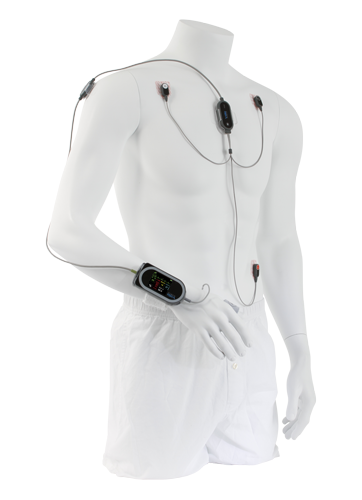The ViSi Mobile System is designed to monitor patients continuously in general care settings.
ViSi Mobile improves patient safety by utilizing machine learning from millions of hours of patient data to recognize patient deterioration while minimizing alarm burden and maximizing clinical workflow.
The ViSi Mobile System Monitors:
![]()
Reducing Cases of Sepsis with ViSi Mobile
Medical-surgical units are too often understaffed and overwhelmed with basic patient care tasks, which can put patients more at risk for developing hospital-acquired infections and sepsis. These patients are also more likely to be missed when experiencing the catastrophic deterioration that occurs with the development of sepsis.
ViSi Mobile gives medical professionals real-time, remote access to vital sign data. This includes early signs and symptoms of sepsis. The device also enables staff to observe trends over time rather than just snapshots of a particular moment, halting sepsis's progress before it becomes life-threatening.
The technology allows medical staff to get on with daily tasks and treat other patients, safe in the knowledge that ViSi Mobile will notify them when vital signs breach previously-chosen parameters. This saves time and energy in the under-staffed and under-funded health sector. The system can be integrated with existing hospital tech, while alarms and updates can be sent to staff phones and uploaded directly to patient records.
According to the Sepsis Alliance, “Sepsis is the number 1 cost of hospitalization in the U.S. Costs for acute sepsis hospitalization and skilled nursing are estimated to be $62 billion annually.” With more than 270,000 lives lost annually, sepsis ranks as the third leading cause of death in the U.S. (after heart disease and cancer).
Discover how continuous surveillance monitoring of all major vital signs (HR, RR, SpO2, and blood pressure) can offer a safety net for overwhelmed and understaffed nursing units.
Limitations of Basic Vital Sign Monitoring

Vital sign collection has generally been ordered according to unit policy and not according to patient need. Dangerous patient deterioration can occur in the interim between physical vital sign spot checks.
1 AHA database, 2013 2 I2_Presentation_Diagnostics_Haraden.pdf
2 I2_Presentation_Diagnostics_Haraden.pdf
3 Schein RM et al. Clinical antecedents to in-hospital cardiopulmonary arrest. Chest 1990;98: 1388-92.

The Benefits of ViSi Mobile Patient Monitoring System
Sotera's ViSi Mobile® Patient Monitoring System is a platform for comprehensive vital signs monitoring that keeps clinicians connected to their patients, whether in bed, in transport or while ambulating. Featuring comfortable body-worn sensors that allow for freedom of movement, the system enables accurate, continuous monitoring of all core vital signs with beat-to-beat, noninvasive blood pressure, as well as patient activity and posture. ViSi Mobile is a system designed to enhance patient safety, allowing early detection of patient deterioration and connecting clinicians with their patients anywhere, any time.



